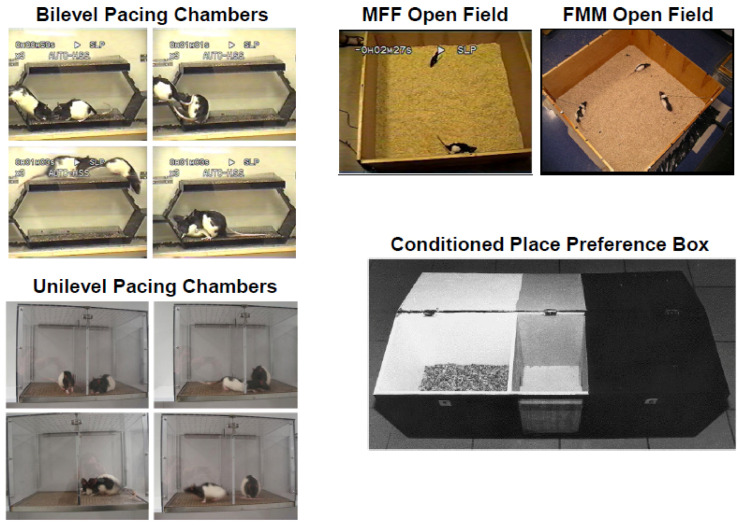Figure 3.
Left: Bilevel and unilevel pacing chambers used for conditioning of partner preferences (adapted from Pfaus et al., [53] with permission. 2015, Elsevier). Pacing chambers allow the female to regulate copulatory contact with the male by either running from level to level (top) or by darting through small holes in a divider that are big enough to allow the female to pass through, but too small to allow the male to pass through (bottom). In the bilevel pacing chambers, females make a head-wise orientation to the male (upper left panel), then hop over him exposing their anogenital area (top right panel). Females then run away, forcing the male to chase them (bottom left panel), after which they run to the original level and assume a lordosis crouch, allowing the male to mount with intromission (bottom right panel). Similarly, in unilevel pacing chambers females can pass through the hole into the male’s side (top left and right panels) and solicit an intromission (bottom left panel), then exit the male’s side (bottom right panel). Each of these sequences depict the initiation and termination of a copulatory bout by the female. Right top: Open fields used for testing conditioned partner preferences and CEP (adapted from Pfaus et al., [53] with permission. 2015, Elsevier). To test CEP, a male is placed into the open field with two females, one scented or jacketed and the other unscented or unjacketed. The male can then copulate freely with either one. To test partner preferences in females, a female is placed with two tethered males, one scented or jacketed, and the other unscented or unjacketed. Males are tethered to avoid their tendency to huddle together. Females compete, so they can remain untethered. Right bottom: Apparatus used to condition and test place preferences after sexual reward training (Reprinted with permission from Paredes and Vasques [54]. 1999. Elsevier). After a requisite amount of copulatory stimulation, a female or male is placed on one side of the box (usually the light side as this is typically not their naturally preferred side). This is contrasted without stimulation, after which the female or male is placed into the naturally preferred (e.g., dark) side. If the copulatory stimulation induces a reward state, then on a final test, after the animal is placed into the middle compartment, it will move to the side with cues that predict the reward state and spend more time there compared to the other side.

